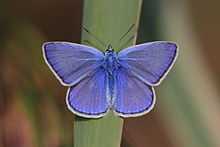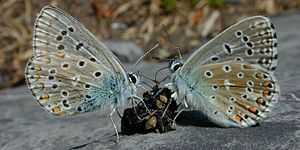Common blue
| Common blue | |
|---|---|
 | |
| Male | |
_female.jpg) | |
| Female | |
| Scientific classification | |
| Kingdom: | Animalia |
| Phylum: | Arthropoda |
| Class: | Insecta |
| Order: | Lepidoptera |
| Family: | Lycaenidae |
| Tribe: | Polyommatini |
| Genus: | Polyommatus |
| Species: | P. icarus |
| Binomial name | |
| Polyommatus icarus (Rottemburg, 1775) | |
The common blue (Polyommatus icarus) is a small butterfly in the family Lycaenidae, widespread over much of the Palaearctic and recently introduced[1] in eastern Canada.
The larva feeds on plants from the family Leguminosae. Recorded foodplants are Lathyrus spp., Vicia spp., Vicia cracca, Oxytropis campestris, Lotus corniculatus, Trifolium pratense, Oxytropis pyrenaica, Astragalus aristatus, Astragalus onobrychis, Astragalus pinetorum, Medicago romanica, Medicago falcata, and Trifolium repens.
Subspecies
- P. i. mariscolore (Kane, 1893) Ireland
- P. i. fuchsi (Sheljuzhko, 1928) South Siberia, Transbaikalia
- P. i. omelkoi Dubatolov & Korshunov, 1995 Amur, Ussuri
- P. i. ammosovi (Kurenzov, 1970) Central Yakutia, Far East, Kamchatka
- P. i. fugitiva (Butler, 1881) Pakistan
- P. i. napaea (Grum-Grshimailo, 1891) Tian-Shan
U.K. and Ireland
Appearance, behaviour, and distribution
Male uppersides are an iridescent lilac blue with a thin black border. Females are brown above with a row of red spots along the edges and usually some blue at the base of the wings; the upperside may be mostly blue, especially in Ireland and Scotland, but it always has red spots. Undersides have a greyish ground colour in the males and a more brownish in the females. Both sexes have a row of red spots along the edge of the hindwings and extending onto the forewings, though they are generally fainter there, particularly in the males, where they are sometimes missing altogether. There are about a dozen black-centered white spots on the hindwings, nine on the forewings. These usually include one in the middle of the forewing cell, absent in Chapman's and Escher's blues.[2] The white fringe on the outer edge of the wings is not crossed with black lines, as it is in the Chalkhill and Adonis blues.
The common blue is Britain's (and probably Europe's) most common and most widespread blue, found as far north as Orkney and on most of the Outer Hebrides. Males are often very obvious as they defend territories against rivals and search out the more reclusive females. A range of grassland habitats are used: meadows, coastal dunes, woodland clearings, and also many man-made habitats, anywhere their food plants are found.
Recently, this butterfly was discovered in Mirabel, Quebec, Canada by Ara Sarafian, an amateur entomologist who observed the butterfly from 2005 to 2008. He contacted the Canadian National Collection of Insects in Ottawa where the butterfly was identified as P. icarus, a new alien butterfly to Canada and to North America. The butterfly seems to be well established and is extending its range from year to year.[1]
Lifecycle and food plants
The main food plant on most sites is Bird's foot trefoil (Lotus corniculatus). Others used include black medick Medicago lupulina, common restharrow (Ononis repens), white clover (Trifolium repens), and lesser trefoil (Trifolium dubium). Eggs are laid singly on young shoots of the food plant.
The caterpillar is small, pale green with yellow stripes and, as usual with lycid larvae, rather slug-like. Hibernation occurs as a half grown larvae. They are attractive to ants, but not as much as some other species of blues. The chrysalis is olive green/brown and formed on the ground, where it is attended by ants, which will often take it into their nests. The larva creates a substance called honeydew, which the ants eat while the butterfly lives in the ant hill. In the south of Britain there are two broods a year, flying in May and June and again in August and September. Northern England has one brood, flying between June and September. In a year with a long warm season, there is sometimes a partial third brood in the south flying into October.
Gallery
-
.jpg)
Male common blue, northern Norway
-

Male (underside)
-

Female (underside)
-
.jpg)
Close-up
-

Two consume feces
-
mating
-

Egg
-
_underside_ab.jpg)
pattern aberration
-
_male_worn.jpg)
worn male
-
_male_very_worn.jpg)
very worn male
Lifestyle
- Diet, caterpillars: leaves of plants
- Diet, Butterflies: wildflower nectar, excrement
- Lifespan: 3 weeks as butterfly
See also
| Wikimedia Commons has media related to Polyommatus icarus. |
References
- ↑ 1.0 1.1 http://www.entsocont.com/Newsletter_Dec_2007.pdf
- ↑ Rowlings, Matt. http://www.eurobutterflies.com/species_pages/icarus.htm. Accessed 23 December 2012.
